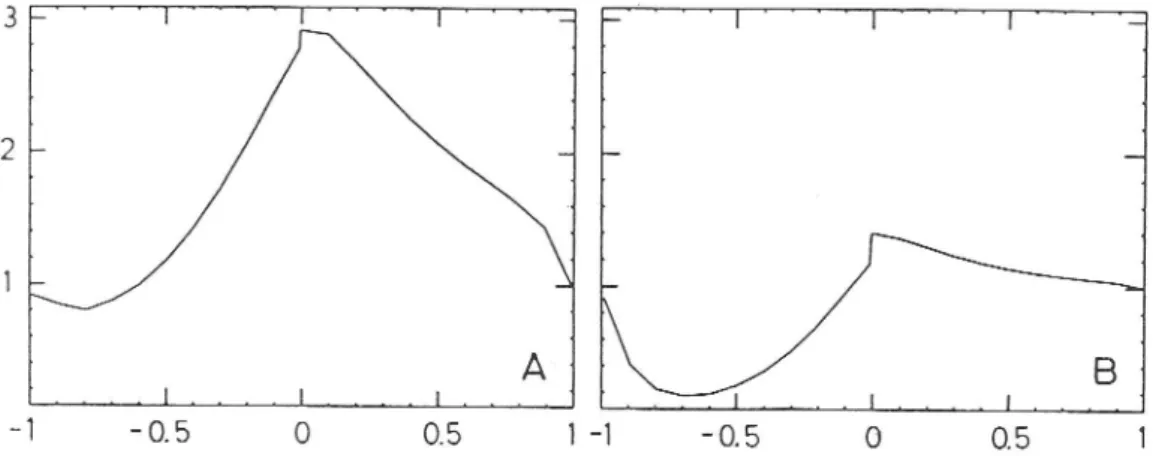Deformation of
P
Cygni
Line
Profiles by
Gravitational
Microlensing
Effects
D.
Hutsemékers,
J.
Surdej,
E. Van Drom
Institut d'Astrophysique, Université de Liège, Belgium
In addition to the well-known induced photometric effects, the gravitational magnification
of
alight
source by stellar-mass lenses may also a^ffect the spectral line profilesif
the different paxts of the profile originate fromdif-ferent emitting regions
in
the source plane andif
the size of these regionsis comparable to the characteristic lensing radius (Kayser et aJ. 1986). As
noticed by Surdej (1990), this may be particularly important for the broad
absorption line (BAL) quasars because the projectéd size of the BALR is
similar
to
that
of the continuum emitting region and therefore compaxa-ble to reasonable lensing radii. Good evidence for such microlensing effectson BAL line profiles is suggested by the spectroscopic observations of the
multiple components of the BAL quasar H1413*117 (Angonin et al. 1990).
In
this context, we have investigated here the effects of the chromatic magnification due to microlensing on the spectrum of BAL quasars assumingthat
they a.re constituted of a central continuum source surrounded by arapidly expanding atmosphere, a model which may account for the observed
P Cygni-type profrles at least in some cases.
In order to delineate the main characteristics of the spectral variations due to microlensing, we have adopted a model that is as simple as
possi-ble. The
P
Cygni-type profiles have been computedin
the frasrework ofthe Sobolev approximation for a rapidly, spherically symmetric, expanding atmosphere which is accelerated outwa,rds around a central core. Both
reso-narlce scattering and collisional excitation have been assumed to contribute to the line formation
Process-The adopted lens was a single point-like star positioned at different pro-jected d,istances from the central core in order to magnify different pa'rts of
th"
"*p*td.ing envelope. The resulting P Cygni-type profiles
were obtained
by integrating over the source plane the spectral intensity of the radiation
frLld
"m"rging from the envelope along the line-of-sight a,nd multiplied
by
the amplification pattern determined
for a
given projected distance andcharacteristic radius of the lens.
Fbr reasonable values of the characteristic lensing radius and BELR size,
D. Hutsemékers et al.: Deformation of P Cygni Line profiles
changes of the profiles may occur. The deformations of the profiles
essen-tially
appeax when the lens is approximately aligned with the source whilethe changes due to a decentered lens remain small.
The modifications of the P Cygni line profiles due to microlensing effects
are mainly characterized by a net increase of the whole absorption
compo-nent relative to the emission one. This increase of the absorption may be strong enough to transform a nearly pure emission line profile into a more
typicai P Cygni-type one.
For plausible values
of
the
transverse velocitiesof
the
source, the observer and the lens, these profile variations may occurwith
a
typicaltimescale of ten years. This order of magnitude is in quite good agreement
with the timescale of line proflle variations reported for some BAL quasars (see e.g. Turnshek et al. 1988; Smiih et al. 1988).
1
-l - 0.5 -lI -0.5
Fig.
t.
An example of line profiles computed with (B) and without (A)microlens-ing effects. In this case, collisional excitation dominates the process of line forma-tion. Abscissae are dimensionless frequencies and ordinates fluxes normalized to the continuum.
This research was supported in part by contract ARC g0lg4-r40 "Action
de recherche concertée de la Communauté Française" (Belgium).
References
Angonin et al. (1990): A&A 233, L5 Kayser et al. (1986): A&A 166, 36
Smith et al. (1988): MNRAS 235,551
Surdej (1990): in Lecture notes in Phys'ics: Grouitqtional lensing, Springer-Verlag Turnshek et al. (1988): ApJ 325,651
This book was processed by the author using the
T$
macro package from Springer-Verlag.0.5 0.5
